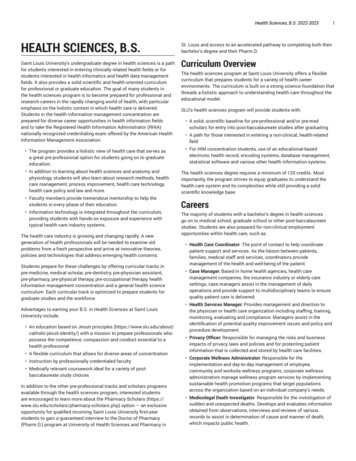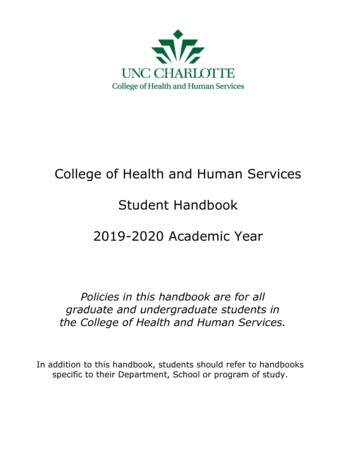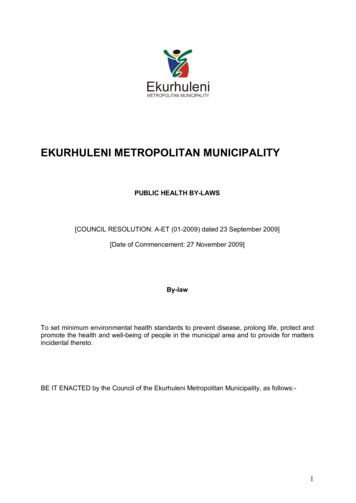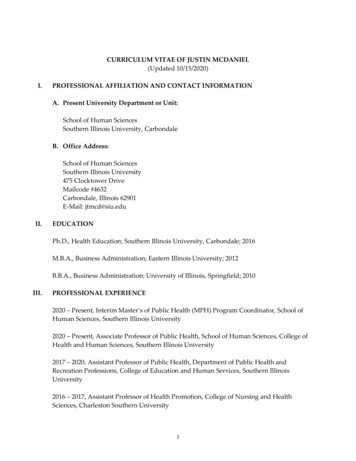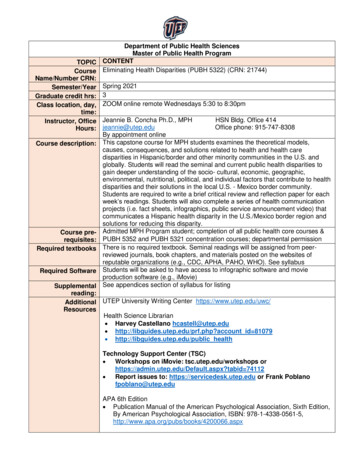
Transcription
Department of Public Health SciencesMaster of Public Health ProgramTOPIC CONTENTCourse Eliminating Health Disparities (PUBH 5322) (CRN: 21744)Name/Number CRN:Semester/Year Spring 2021Graduate credit hrs: 3Class location, day, ZOOM online remote Wednesdays 5:30 to 8:30pmtime:HSN Bldg. Office 414Instructor, Office Jeannie B. Concha Ph.D., MPHjeannie@utep.eduOfficephone: 915-747-8308Hours:By appointment onlineCourse description: This capstone course for MPH students examines the theoretical models,causes, consequences, and solutions related to health and health caredisparities in Hispanic/border and other minority communities in the U.S. andglobally. Students will read the seminal and current public health disparities togain deeper understanding of the socio- cultural, economic, geographic,environmental, nutritional, political, and individual factors that contribute to healthdisparities and their solutions in the local U.S. - Mexico border community.Students are required to write a brief critical review and reflection paper for eachweek’s readings. Students will also complete a series of health communicationprojects (i.e. fact sheets, infographics, public service announcement video) thatcommunicates a Hispanic health disparity in the U.S./Mexico border region andsolutions for reducing this disparity.Course pre- Admitted MPH Program student; completion of all public health core courses &requisites: PUBH 5352 and PUBH 5321 concentration courses; departmental permissionRequired textbooks There is no required textbook. Seminal readings will be assigned from peerreviewed journals, book chapters, and materials posted on the websites ofreputable organizations (e.g., CDC, APHA, PAHO, WHO). See syllabusRequired Software Students will be asked to have access to infographic software and movieproduction software (e.g., iMovie)Supplemental See appendices section of syllabus for listingreading:Additional UTEP University Writing Center https://www.utep.edu/uwc/ResourcesHealth Science Librarian Harvey Castellano hcastell@utep.edu http://libguides.utep.edu/prf.php?account id 81079 http://libguides.utep.edu/public healthTechnology Support Center (TSC) Workshops on iMovie: tsc.utep.edu/workshops orhttps://admin.utep.edu/Default.aspx?tabid 74112 Report issues to: https://servicedesk.utep.edu or Frank Poblanofpoblano@utep.eduAPA 6th Edition Publication Manual of the American Psychological Association, Sixth Edition,By American Psychological Association, ISBN: 00066.aspx
TOPIC CONTENTCourse format Lecture & discussion, in-depth readings/reflective responses, student oral &written presentation, class learning project.THE COUNCIL ONEDUCATION FOR The UTEP MPH program is nationally accredited by the Council on Education forPUBLIC HEALTH Public Health (CEPH). The CEPH has defined 22 foundational competenciesFOUNDATIONAL required for attainment of the MPH degree; in addition, our MPH program hasAND defined 5 concentration competencies that reflect the unique training that you willCONCENTRATION receive in our program in Hispanic and Border Health. During orientation, youCOMPETENCIES were provided with the complete list of the foundational and concentration(CEPH) competencies. Each of your courses will address different competencies. Thecompetencies that will be addressed in this course are listed below and duringthe first class session, your professor will review these with you. In differentways throughout the semester, you will be evaluated on your knowledgeregarding the specific competencies addressed in this course, and you will beassessed on your ability to apply each of the competencies addressed in thiscourse.CourseCompetenciesEvidence-based Approaches to Public Health4. Interpret results of data analysis for public health research, policy or practicePublic Health & Health Care Systems6. Discuss means by which structural bias, social inequities, racism underminehealth/create challenges in health equity at organizational, community, societallevelsPlanning & Management to Promote Health7. Assess population needs, assets and capacities that affect communities’healthPolicy in Public Health15. Evaluate policies for their impact on public health and health equityCommunication18. Select communication strategies for different audiences and sectors19. Communicate audience-appropriate public health content, both in writing andthrough oral presentation20. Describe the importance of cultural competence in communicating publichealth contentMPH Hispanic and Border Health Concentration Competencies1. State and discuss the current major communicable, non-communicable, andenvironmental public health threats in Hispanic and border communities.2. State the basic principles of prevention and control of communicable andnon-communicable disease; discuss how these principles can be modified toaccommodate cultural values and practices in Hispanic and bordercommunities.4. Identify, access and summarize the content of one or more current initiativesrelevant to border health (e.g., Healthy Border 2020; US-Mexico BorderPhilanthropy Partnership; Paso Del Norte Regional Strategic HealthFramework)5. Identify health disparities and approaches to achieving health equity.
TOPIC CONTENT1. Weekly written reflective responses on reading assignmentsAssessment2. Complete a well written fact sheet on a Hispanic Health Disparity issue forstrategieslocalpopulation as the audience3. Create an Infographic on a Hispanic Health Disparity issue for localpopulationas the audience4. Work as a team to create a short Public Service Announcement5. Class participationBythe end of this course, students will be able to:Learning objectives1. Discuss the evolution of health disparities and health equity assubjects of study and public health action.2. Identify the multiple dimensions of health disparities as described inHealthy People 2030. Describe how the selection of reference groups canaffect the measurement of health disparities.3. P r esent health disparities in graphic and video health communicationsform.4. Compare and contrast ethnic/racial and other health disparities in theU.S. population.5. Use the socioecological framework to inform and design socialmarketing interventions to eliminate health disparities and increasehealth equity.6. Critically assess existing programs & policies designed to eliminate healthdisparities in US groups.7. Present informational marketing tools on a major Hispanic healthdisparity and recommend practical strategies for its reduction;8. Collaborate to produce a social marketing video of the major healthdisparities affecting border groups that can be used as an authoritativesource by policy makers, public health practitioners, and the public.Grading scale Grading scale: A 404 or more ( 90%-exceptional graduate-level performance) B 360 – 403 (80-89%-average graduate-level performance) C 315 – 359 (70-79%-below average graduate-level performance) D 270 – 314 (60-69%-unacceptable graduate-level performance ) F less than 225 ( 60%-very unacceptable graduate-level performance)Grading componentsPoint ValueAssignmentDue Date Up to 220 Written critical review and Monday end of daypointsreflective papersprior to class meetingson Wednesday Student led discussion onassigned week (2 per student10 points each) Assigned weeks Up to 20points
Fact Sheet andInfographic/OpEd Dissemination Matrix Preliminary Factsheetand Infographic PlanDue Final Products February 8th March 8th May 5th Up to 100points
TOPIC CONTENTGrading components Group Project Preliminary Plan Presentations Final Product Peer group evaluation oncontribution to PSA February 13April 28th and May 5thMay 12thLast day of class Up to 100points Up to 10 pointsTotal 450 pointsIncomplete policy The grade of “I” (incomplete) is considered only in very rare circumstancesinvolving fully documented emergencies, must be requested at least four weeksprior to the last class of the fall term, and is allowed at the discretion of theinstructor.Incomplete assignments will be graded for partial credit.It is UTEP policy that all students attend all scheduled classes. Attendance will betaken at each class. When a student registers for a course, it is assumed thatshe/he has made arrangements to avoid conflicts that would result in chronictardiness or absence from class. Students are personally responsible for allinformation or activities presented in class discussions, lectures, assignments,and/or readings. If you are unable to attend class, it is your responsibility to informthe instructor before the class session. Students will be administratively withdrawnfor excessive unexcused absences of 2 or more classes. Compliance ismandatory with regard to assignment due dates, student-led discussions and classpresentations, reading assignments, exams and all other activities. All emergencyrelated absences must be documented and verified by presentation of documentsto the instructor. Chronic tardiness not only reflects lack of commitment andprofessional behavior but also is disruptive to your classmates and the instructor.You are expected to be seated and ready to begin class at 5:00 PM.Reading All assigned readings need to be completed prior to coming to the next scheduledassignments class session. Example: Complete the reading assignments for week 2 prior tocoming to the week 2 class session.AttendanceWriting standards Effective public health leaders and practitioners are also effective written as well asoral communicators. Written communication is a critical element of thecommunication process. Our MPH graduate program both recognizes and expectsgood writing to be the norm for course work. Please feel free to seek outassistance from the UTEP Writing Center. It is free and they are very helpful.Late Assignment Due dates for homework, exams, presentations and other assignments arePolicy designed for fairness to all students. No exceptions to those dates will be madeexcepting in cases of university-designated closures. Five (5) points will bededucted for each day an assignment is late (including weekend days).Permission to record Not permitted without express permission of the instructor.
TOPIC CONTENTClassroom Please note that all cellular telephones, Apple or Android tablets and Laptopselectronics must be used for the purpose of enhancing the learning environments.The use of headphones, iPods, mp3 players, earpieces and other forms ofentertainment technology equipment must be powered off and put awayduring the class period. If a situation should arise, for example, when aphysician or family member contacts a student, the student must be notify theinstructor and cell phone can be set to “vibrate.”Please be advised that students who use unauthorized technology duringclass time will be dismissed from that week’s class session.Class Participation Due to Remote Online course reformat, you will be required to participate inonline live group discussions and complete course assignments. I will sendeveryone a Zoom link each week for our discussions Thursday starting at5pm.Specialaccommodations If you have a disability and need classroom accommodations, please contactThe Center for Accommodations and Support Services (CASS) at915.747.5148, cass@utep.edu, or visit their office located in UTEP UnionEast, Room 106. For additional information, visit http://sa.utep.edu/cass/.CASS Staff are the only individuals who can validate and authorizeaccommodations for students with disabilities.UTEP MPH Program Available atHandbook 0STUDENT%20%20HANDBOOK%202013-2014.pdfStudent conduct “Scholastic dishonesty includes but is not limited to cheating, plagiarism,collusion, and the submission for credit of any work or materials that areattributable in whole or in part to another person, taking an examination foranother student, any act designed to give unfair advantage to a student or theattempt to commit such acts.” University of Texas Regent’s Rules andRegulations, Part One, Chapter VI, Section 3.2, Subdivision 3.22.FOR THE PUBLIC HEALTH PROFESSIONAL, ETHICAL CONDUCT IS ACENTRAL TENET AND GUIDING PRINCIPLE OF ALL ACTIVITIES,DECISIONS AND CRITICAL ANALYSES. STUDENTS IN THE MASTERSOF PUBLIC HEALTH PROGRAM AT UTEP ARE EXPECTED TO BE ABOVEREPROACH IN ALL SCHOLASTIC ACTIVITIES.Students who engage in scholastic dishonesty will be subject to disciplinarypenalties, including failure in the course and dismissal from the university. “Itis an official policy of university that all suspected cases or acts of allegedscholastic dishonesty must be referred to the Dean of Students forinvestigation and appropriate disposition. Any student who commits an act ofscholastic dishonesty is subject to discipline. Scholastic dishonesty includes,but is not limited to cheating, plagiarism, collusion, the submission for credit ofany work or materials that are attributable in whole or in part to anotherperson, taking an examination for another person, any act designed to giveunfair advantage to a student or the attempt to commit such px?tabid 4386)
“CHEATING” means copying from the work another student; possessionand/or use during an exam or home test of materials which are not authorizedby the person giving the test; using, obtaining, or attempting to obtain by anymeans the whole or any part of non-administered test, test key, homeworksolution, or computer program; falsifying research data, laboratory reports,and/or other records or academic work offered for credit.“PLAGIARISM” means the appropriation, buying, receiving as a gift, orobtaining by any means another's work and the unacknowledged submissionor incorporation of it in one's own academic work offered for credit, or usingwork in a paper or assignment for which the student had received credit inanother course without direct permission of all involved instructors. NOTE:This includes cutting-and-pasting and photocopying from on-line and othermaterial.“COLLUSION” means the unauthorized collaboration with another person inpreparing academic assignments offered for credit or collaboration withanother person to commit a violation of any provision of the rules onscholastic dishonesty. Using, obtaining, or attempting to obtain by any means the whole orany part of non-administered test, test key, homework solution, orcomputer program; using a test that has been administered in priorclasses or semesters but which will be used again either in wholeor in part without permission of the instructor; or accessing a testbank without instructor permission; Collaborating with or seeking aid from another student for anassignment without authority; Substituting for another person, or permitting another person tosubstitute for one's self, to take a test; Falsifying research data, laboratory reports, and/or other records oracademic work offered for credit.“Plagiarism” means the appropriation, buying, receiving as a gift, orobtaining by any means another's work and the unacknowledgedsubmission or incorporation of it in one's own academic work offered forcredit, or using work in a paper or assignment for which the student hadreceived credit in another course without direct permission of all involvedinstructors. NOTE: This includes cutting-and-pasting and photocopyingfrom on-line and other material.“Collusion” means the unauthorized collaboration with another person inpreparing academic assignments offered for credit or collaboration withanother person to commit a violation of any provision of the rules onscholastic dishonesty.
Assessment of MPH Foundational CompetenciesLearningObjectiveEvidence-based Approaches to Public Health4. Interpret results of data analysis for public health research, policy or practice2,3,4,5Assessment: Knowledge gained through weekly readings and student lead discussions onseminal health disparities and epidemiological research articles. Students will also access largescale databases (e.g. BRFSS) to assess disparities of a specific health issue. Application isassessed through weekly written critical review of assigned readings and class discussion ofassigned readings.Public Health & Health Care Systems6. Discuss means by which structural bias, social inequities, racism undermine1, 5,9health/create challenges in health equity at organizational, community, societallevelsAssessment: Knowledge gained through weekly readings and student lead discussions onseminal health disparities and epidemiological research articles. Students will also access largescale databases (e.g. BRFSS) to assess disparities of a specific health issue. Application isassessed through weekly written critical review of assigned readings and class discussion ofassigned readings.Planning & Management to Promote Health7. Assess population needs, assets and capacities that affect communities’ health2, 6,7,Assessment: Knowledge gained through students’ review of US-Mexico or Hispanic CommunityHealth Assessments and Reports as part of the course project requirements. Application of thisknowledge is assessed through the in class presentation and completion of a public health/healthdisparity fact sheet and infographic which is required to include assets, resources, and localcapacity.Policy in Public Health15. Evaluate policies for their impact on public health and health equity1,2,7Assessment: Knowledge gained through weekly readings and student led discussions on publichealth policy readings and activities (e.g., federal public health budget/housing). Application of thisknowledge is assessed through weekly written critical review and reflection of assigned readingsand activities.Communication18. Select communication strategies for different audiences and sectors6,7,8,9Assessment: Knowledge gained through the completion of a public health fact sheet, infographic,and PSA video that communicates a Hispanic Health Disparity with available resources to addressselected disparity. Application of this knowledge is assessed through the design and use ofinfographic website tools in the design and creation of a complementary fact sheet and infographic.Application of this knowledge is also gained via group design and development of a PSA usingvideo making technology (e.g. iMovie).19. Communicate audience-appropriate public health content, both in writing and6,7,8,9through oral presentationAssessment: Knowledge gained through the completion of a public health fact sheet, infographic,and PSA video that communicates a Hispanic Health Disparity with available resources to addressselected disparity. Application of this knowledge is assessed through the completion andpresentation of a fact sheet, infographic, and PSA. Students must present their projects to theirpeers and a public forum to departmental faculty and students, where their projects will be judgedby departmental faculty and students on readability, visual effects, content, and cultural andlinguistic competency.20. Describe the importance of cultural competence in communicating public health6,8,9contentAssessment: Knowledge gained through the completion of a public health fact sheet, infographic,and PSA video that communicates a Hispanic Health Disparity. Application of this knowledge isassessed through the incorporation of the National CLAS standards in the projects.
MPH Hispanic and Border Health Concentration CompetenciesLearningObjective1,2,51. State and discuss the current major communicable, non-communicable, andenvironmental public health threats in Hispanic and border communities.Assessment: knowledge is gained through weekly readings and student-led discussions onseminal health disparities literature and documentary videos. Knowledge and application of thecompetency is assessed through weekly 3-page written critical review and reflection of readingsand videos. Knowledge and application is also assessed though evaluation of studentsparticipation in class discussions regarding the weekly readings.2. State the basic principles of prevention and control of communicable and non1,5,7communicable disease; discuss how these principles can be modified toaccommodate cultural values and practices in Hispanic and border communities.Assessment: knowledge is gained through student’s review of National Partnership for Action toEnd Health Disparities recommendations and identification of one Hispanic heath priority inHealthy Border 2020 or US-Mexico Border Community Health Assessment Reports for theircourse projects. Application of the competency is assessed through the completion of a fact sheetand infographic with statistical information on the Hispanic health priority area and prevention andcontrol resources available to the Hispanic population. Accommodating cultural values is assessedby determining if the health communication factsheets and infographics meet CLAS (Culturally andLinguistically Appropriate Services) standards, assessing knowledge and application of thecompetency.4. Identify, access and summarize the content of one or more current initiatives4,6,8,9relevant to border health (e.g., Healthy Border 2020; US-Mexico BorderPhilanthropy Partnership; Paso Del Norte Regional Strategic Health Framework).Assessment: Knowledge gained through student’s review of US-Mexico regional initiatives toaddress the US-Mexico border heath priority selected by the students. Application is assessedthrough the completion of a fact sheet, infographic, and PSA video with initiatives listed as availableresources/services on health priority.5. Identify health disparities and approaches to achieving health equity.2,4,57Assessment: knowledge is gained through student’s reading and viewing of required coursereadings and health disparities documentary videos. Knowledge and application of the competencyis assessed through the completion of weekly written summary, critical review, and reflection of thereadings. In addition, application is assessed by a student’s participation in weekly classdiscussions on assigned readings and videos. Application of this competency will also bedetermined by a student’s ability to identify a health disparity for their course projects.
WEEKLY PLANZOOM link for d WjhKTUI1K3Y4eWxmdm14MDE1VDdwQT09DATESWeekly Topics & DiscussionsAssigned RequiredReadings OtherAssignments DUEWEEK 1Jan 20Course overview/assignments, Orientation to projectIntroduction to National Institute of Minority andHealth Disparities (NIMHD) & National Partnership toEnd Health DisparitiesWeek 2 ReadingsAssignmentsCultural CompetencyCertificate DUE Jan 20thCompetency : MPH Hispanic and Border Health Concentration Competencies6. Identify health disparities and approaches to achieving health equity.Communication Competency20. Describe the importance of cultural competence in communicating public health contentWEEK 2Jan 27Overview of health disparities & health equitySocial determinants of health & health disparitiesUnnatural Causes: In Sickness and in Wealth (56minutes)Week 2 Summary ReflectionPaper DUE Jan 28thWeek 3 Readings AssignedDiscussionCompetency: Policy in Public Health15. Evaluate policies for their impact on public health and health equityEvidence-based approaches to Public Health4.Interpret results of data analysis for public health research, policy or practice20. Describe the importance of cultural competence in communicating public health contentWEEK 3Feb 3Health Communications to Eliminate Disparities1. Health messagingWeek 3 Summary ReflectionPaper DUE February 1stWeek 4 CommunicationDissemination PlanCompetency : Communication18. Select communication strategies for different audiences and sectors19. Communicate audience-appropriate public health content, both in writing and through oralPresentation20. Describe the importance of cultural competence in communicating public health content
WEEK 4Feb 10Review Student Health Communication PlansUnnatural Causes: When the bough breaks (29minutes)DiscussionWeek 4 Summary ReflectionPaper DUE February 8thSTUDENTS PRESENTPLAN FEB 10th DUEWeek 5 Readings AssignedCompetency : Public Health & Health Care Systems4. Discuss means by which structural bias, social inequities, racism undermine health/createchallenges in health equity at organizational, community, societal levelsWEEK 5Education and Health DisparitiesWeek 5 Summary ReflectionFeb 17CommunicationUnnatural Causes: Becoming American (29 minutes)Paper DUE February 15th18. SelectDiscussioncommunication strategies for different audiences and sectors20. Describe the importance of cultural competence in communicating Weekpublic 6healthcontentReadingsAssignedCompetency : Public Health & Health Care Systems6. Discuss means by which structural bias, social inequities, racism undermine health/createchallenges in health equity at organizational, community, societal levelsPlanning & Management to Promote Health7. Assess population needs, assets, and capacities that affect communities’ healthCommunication19. Communicate audience-appropriate public health content, both in writing and through oralPresentationMPH Hispanic and Border Health Concentration Competencies4. Identify, access and summarize the content of one or more current initiatives relevant to borderhealth.WEEK 6Economic Stability and Health DisparitiesWeek 6 Summary ReflectionFeb 24Unnatural Causes: Bad Sugar (29 minutes)Paper DUE February 22ndDiscussionWeek 7 Readings AssignedCompetency: Public Health & Health Care Systems6. Discuss means by which structural bias, social inequities, racism undermine health/createchallenges in health equity at organizational, community, societal levelsWEEK 7March 3Health and Health Care – Health DisparitiesUnnatural Causes: Place Matters (29 minutes)Week 7 Summary ReflectionPaper DUE March 1stWeek 8 Readings AssignedCompetency: Public Health & Health Care Systems6. Discuss means by which structural bias, social inequities, racism undermine health/createchallenges in health equity at organizational, community, societal levelsWEEK 8Mar 10Social and Cultural Context: Implicit Bias andStereotypingUnnatural Causes: Collateral Damage (29 minutes)Week 8 Summary ReflectionPaper DUE March 8thWeek 10 Readings Assigned
Competency: Public Health & Health Care Systems6. Discuss means by which structural bias, social inequities, racism undermine health/createchallenges in health equity at organizational, community, societal levelsWEEK 9Mar 17thWEEK 10March 24thSPRING BREAK (no class March 17th)US Mexico Health Readings and videoRace the Power of an Illusion: The difference betweenus DiscussionWeek 10 SummaryReflection PaperDUE March 22ndWeek 11 Readings AssignedCompetency : MPH Hispanic and Border Health Concentration Competencies2. State the basic principles of prevention and control of communicable and no communicabledisease: discuss how these principles can be modified to accommodate cultural values andpractices in Hispanic and border communities. Identify health disparities and approaches toachieving health equity.WEEK 11March 31stHispanic Health DisparitiesRace the Power of an Illusion: The story we tellDiscussionWeek 12 Summary ReflectionPaperDUE March 29thWeek 12 Readings AssignedCompetency: Public Health & Health Care Systems6. Discuss means by which structural bias, social inequities, racism undermine health/createchallenges in health equity at organizational, community, societal levelsWEEK 12April 7thHispanic Health DisparitiesRace the Power of an Illusion: The house we live inDiscussionWeek 12 SummaryReflection PaperDUE April 5thCompetency: Public Health & Health Care Systems6. Discuss means by which structural bias, social inequities, racism undermine health/createchallenges in health equity at organizational, community, societal levelsWEEK 13Apr 14thWork on Group ProjectsDiscuss means by which structural bias, social inequities, racism undermine health/createchallenges in health equity at organizational, community, societal levelsCompetency : Communication18. Select communication strategies for different audiences and sectors19. Communicate audience-appropriate public health content, both in writing and through oralPresentation20. Describe the importance of cultural competence in communicating public health content
WEEK 14April 21st Online Class Group Presentation – DiscussionCompetency : Communication18. Select communication strategies for different audiences and sectors19. Communicate audience-appropriate public health content, both in writing and through oralPresentation20. Describe the importance of cultural competence in communicating public health contentWEEK 15April 28th Online Class Group Presentation – DiscussionFact Sheets andInfographicsDUECompetency : Communication18. Select communication strategies for different audiences and sectors19. Communicate audience-appropriate public health content, both in writing and through oralPresentation20. Describe the importance of cultural competence in communicating public health contentWEEK 16May 5thTurn in Final Projects to blackboard or email
SPRING 2021 SEMESTEREliminating Health Disparities(PUBH 5322)INDIVIDUAL READING ASSIGNMENTS: REFLECTIVE RESPONSES PAPER. You must include information from all articles in your reflective paper (referencearticles). The length of the reflection reviewed must be 3 full pages not includingreferences (Times New Roman 11 font, double -spaced, APA style). Turn in theseassignments on blackboard the Wednesday end of day before class. There will be a total of 9reflection papers worth 20 points each.1. Synthesized summary: Please provide an overview and synthesizedsummary of the assigned readings. This summary can address either ofthe following questions:a) Overall topic and theme of the readingsb) What are the major questions raised by the author(s) of the article?c) What are the underlying as
4. Work as a team to create a short Public Service Announcement 5. Class participation Learning objectives By the end of this course, students will be able to: 1. Discuss the evolution of health disparities and health equity as subjects of study and public health action. 2. Identify the multiple dimensions of health disparities as described in

